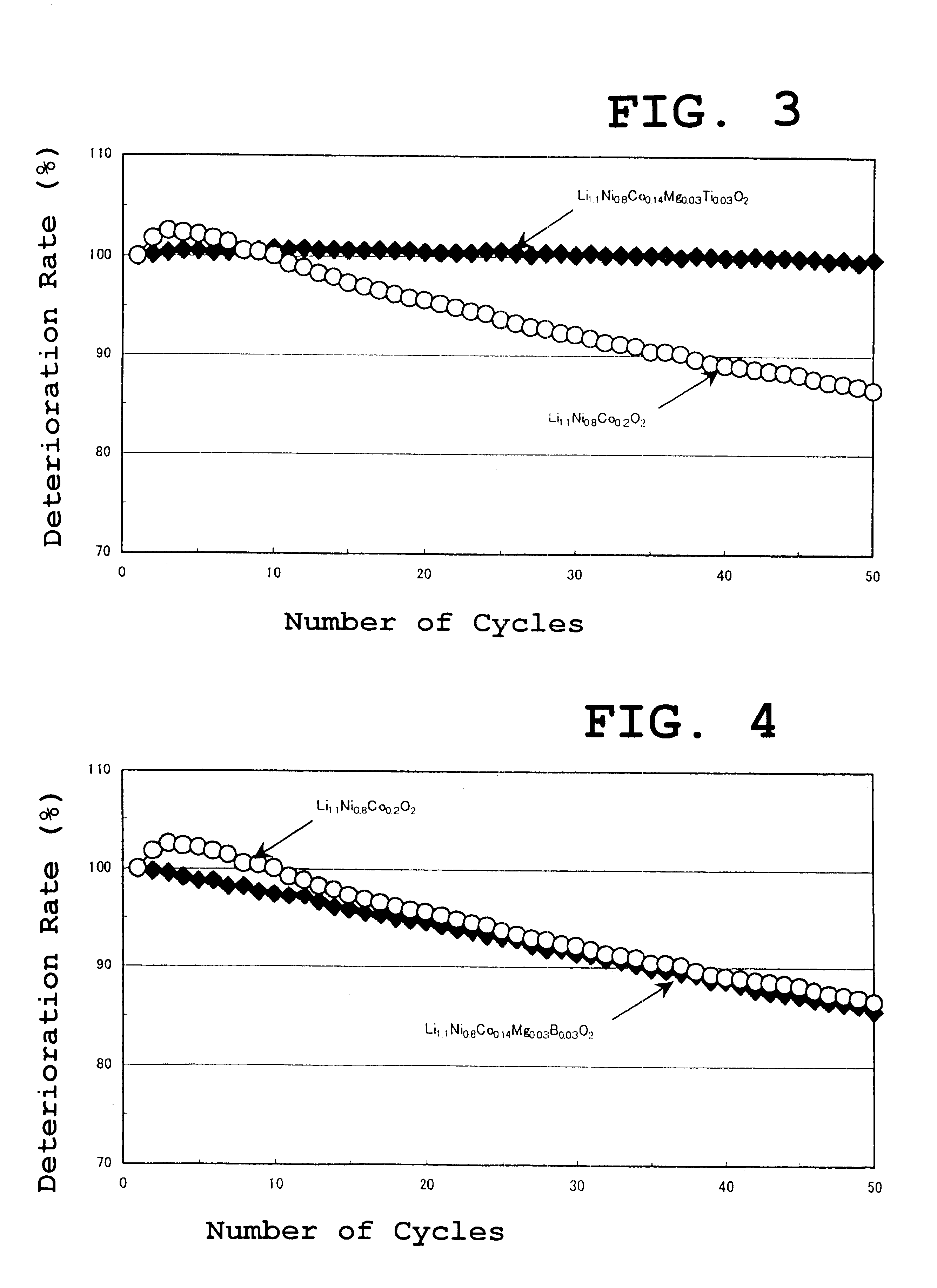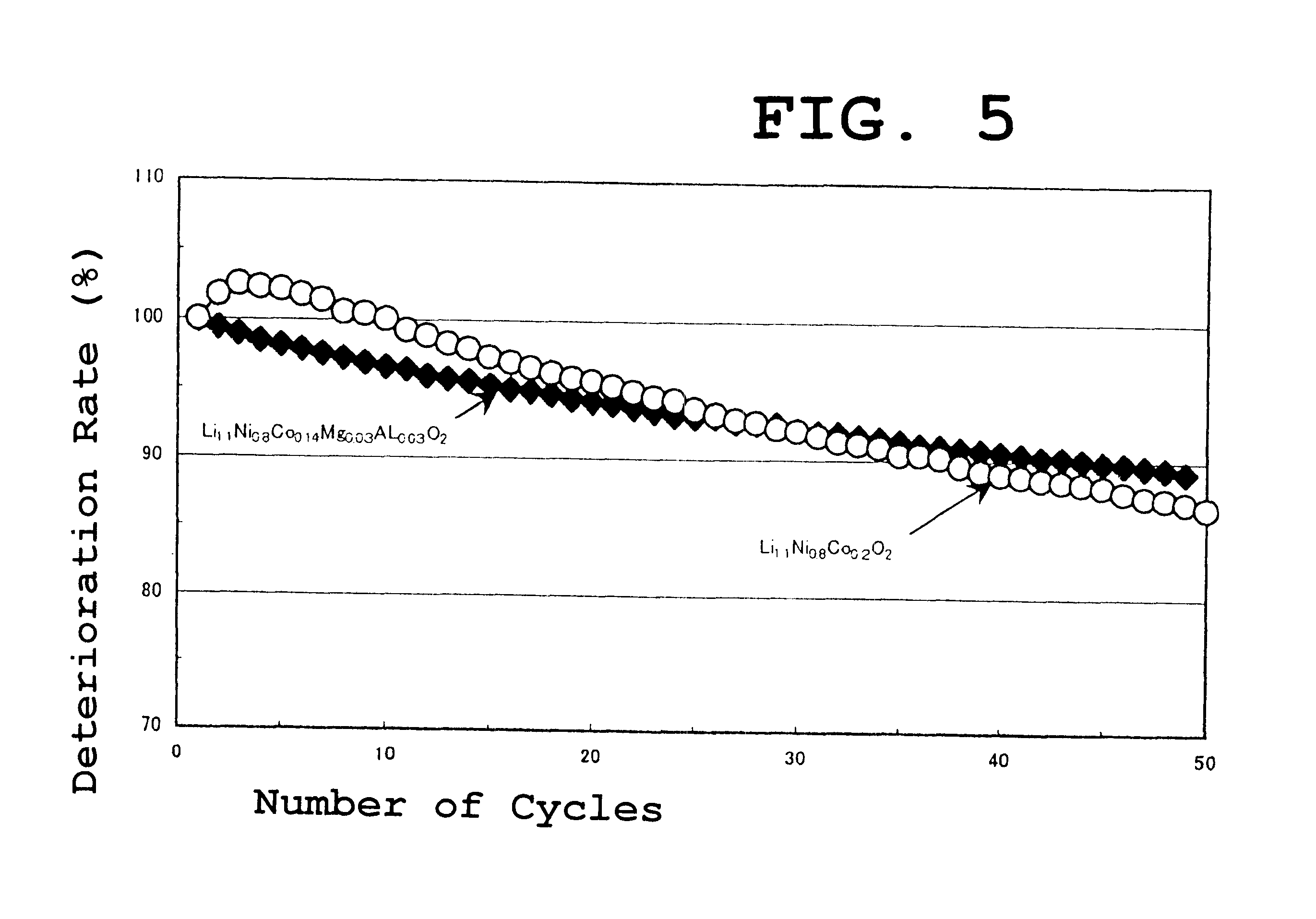Cathode material for a lithium secondary battery and method for manufacturing same
a lithium secondary battery and cathode material technology, applied in the direction of magnesium compounds, lithium compounds, aluminium oxides/hydroxides, etc., can solve the problems of compound disadvantages in terms of stable supply and cost, insufficient thermal stability, and limited cobalt reserves, etc., to achieve excellent cycle properties and high capacity
- Summary
- Abstract
- Description
- Claims
- Application Information
AI Technical Summary
Benefits of technology
Problems solved by technology
Method used
Image
Examples
example 1
Metallic nickel and metallic cobalt were measured as to be Ni:Co=0.8:0.14 (mole ratio, hereinafter the same) and dissolved in a 50 wt. % sulfuric acid solution.
Magnesium nitrate, titanium chloride, and ammonium tetraborate were added to the resultant solution as to be Ni:Co:Mg:Ti:B=0.8:0.14:0.02:0.02:0.02 and the concentration of the solution was adjusted as to control the total of nickel, cobalt, magnesium, titanium, and boron of 60 g / L.
Further, ammonium chloride was added to the solution to control pH to about 5, and then a 6 mol / L sodium hydroxide solution was added to coprecipitate mixed hydroxides. The hydroxides after coprecipitation were washed several times and then dried. The obtained powder was spherical and formed in a whisker-like primary particle.
LiOH--H.sub.2 O was then added to the powder as to be Li: (Ni+Co+Mg+Ti+B)=1.1:1 and mixed and fired at 750.degree. for 10 hours.
As a result of phase identification by x-ray diffraction, the obtained compound had a layered rock ...
example 2
A similar experiment was carried out using Al instead of B as in example 1. As the Al compound, aluminum nitrate was used. The results were almost similar to those of the example 1. In the case of other combinations, the results were similar.
The results of the active material capacity and the thermal stability of the lithium nickelcobaltate obtained in the above described example 2 are shown in Table 1 as well.
example 3
The mixed hydroxides obtained in example 1 and LiOH--H.sub.2 O were mixed in the same ratio and fired at 550.degree. C. in an oxygen atmosphere for 24 hours and then pulverized and further fired at 750.degree. C. for 5 hours. Although the cycle property and the thermal stability were the same as those of the foregoing examples, the active material capacity was 180 mAh / g or higher. The results of the active material capacity and the thermal stability of the lithium nickelcobaltate obtained in the above described example 3 are shown in Table 1 as well.
PUM
| Property | Measurement | Unit |
|---|---|---|
| temperature | aaaaa | aaaaa |
| ion radius | aaaaa | aaaaa |
| cut-off voltage | aaaaa | aaaaa |
Abstract
Description
Claims
Application Information
 Login to View More
Login to View More - R&D
- Intellectual Property
- Life Sciences
- Materials
- Tech Scout
- Unparalleled Data Quality
- Higher Quality Content
- 60% Fewer Hallucinations
Browse by: Latest US Patents, China's latest patents, Technical Efficacy Thesaurus, Application Domain, Technology Topic, Popular Technical Reports.
© 2025 PatSnap. All rights reserved.Legal|Privacy policy|Modern Slavery Act Transparency Statement|Sitemap|About US| Contact US: help@patsnap.com



